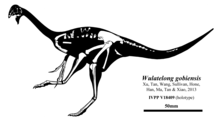Wulatelong
| Wulatelong Temporal range:Campanian,
| |
|---|---|
| Scientific classification | |
| Domain: | Eukaryota |
| Kingdom: | Animalia |
| Phylum: | Chordata |
| Clade: | Dinosauria |
| Clade: | Saurischia |
| Clade: | Theropoda |
| Family: | †Oviraptoridae |
| Genus: | †Wulatelong Xuet al.,2013 |
| Type species | |
| †Wulatelong gobiensis Xuet al.,2013
| |
Wulatelongis anextinctgenusofbasaloviraptoriddinosaurknown from theLate CretaceousWulansuhai Formation(Campanianstage) of Bayan Mandahu,Linhe DistrictofInner Mongolia,northernChina.It contains a singlespecies,Wulatelong gobiensis.[1]
History
[edit]
The fossils ofWulatelong,representing a single nearly-complete skeleton, now cataloged IVPP V 18409, were discovered in 2009 in theBayan Mandahuarea of Wulatehouqi, Inner Mongolia, a fossil-rich area which has yielded many recent dinosaur discoveries. The authors of the paper describingWulatelonghad previously described the dromaeosauridLinheraptor(2010), the alvarezsauridLinhenykus(2011), and the troodontidLinhevenator(2011).Wulatelongwas described by Xuet al.in 2013. The generic name derives fromWulate,where the fossils were discovered, andlong,the Chinese word for "dragon". The specific name,gobiensis,refers to theGobi Desert.[1]
Classification
[edit]Wulatelongis anoviraptoriddinosaur, the sister taxon ofBanji.[2]Oviraptorids were bird-like, herbivorous and omnivoroustheropodscharacterized by toothless, parrot-like beaks, and often elaborate crests. They are known only from the Late Cretaceous of Asia.

Paleoecology
[edit]Wulatelongshared their habitat in the Bayan Mandahu with a number of other dinosaurian fauna. These included the ceratopsiansProtoceratopsandMagnirostris,the ankylosaurianPinacosaurus,and a number of other theropods: the dromaeosauridsVelociraptor,‘’Papiliovenator’’ andLinheraptor,the oviraptorosaurianMachairasaurus,the alvarezsauroidLinhenykus,and the troodontidLinhevenator.The authors of the paper describingWulatelongconcluded that the Bayan Mandahu fauna "differs fundamentally in composition from the classicalDjadokhtafauna, perhaps because of a difference in age "or due to environmental factors.[1]
See also
[edit]References
[edit]- ^abcXu Xing; Tan Qing-Wei; Wang Shuo; Corwin Sullivan; David W. E. Hone; Han Feng-Lu; Ma Qing-Yu; Tan Lin & Xiao Dong (2013)."A new oviraptorid from the Upper Cretaceous of Nei Mongol, China, and its stratigraphic implications"(PDF).Vertebrata PalAsiatica.51(2):85–101.
- ^Lamanna, M. C.; Sues, H. D.; Schachner, E. R.; Lyson, T. R. (2014)."A New Large-Bodied Oviraptorosaurian Theropod Dinosaur from the Latest Cretaceous of Western North America".PLOS ONE.9(3): e92022.Bibcode:2014PLoSO...992022L.doi:10.1371/journal.pone.0092022.PMC3960162.PMID24647078.










